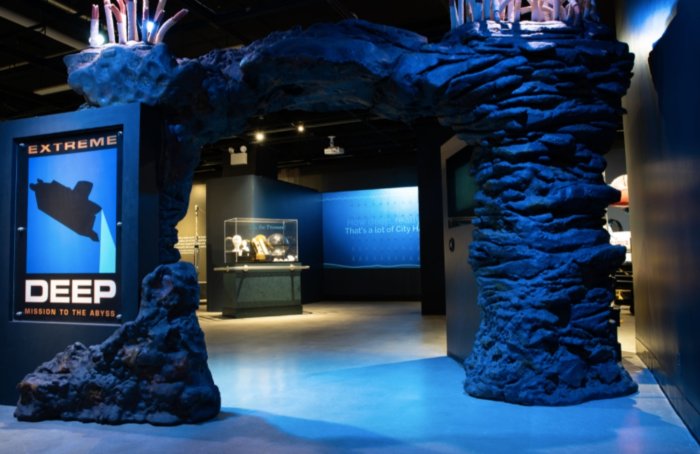We know the ocean is the most unexplored part of the planet with more than 80% of it still being a mystery. However, the Academy of Natural Sciences of Drexel University and its latest exhibit is here to help shine a light on the darkest parts of Neptune’s stomping ground—and you can have a front row seat.
With ‘Extreme Deep: Mission to the Abyss,’ Philadelphians have the opportunity to take a peek into newly discovered life forms, bubbling thermal vents, compact research submersibles, and shipwrecks—just to name a few of the highlights.
“These days you need to go deep to discover something never before seen in the history of life on Earth,” said Mark Sabaj, PhD, collection manager of fishes at the Academy of Natural Sciences in a statement. “Paleontologists do this by searching rocks in deep time. Oceanographers do this by searching the depths of our oceans. What they have found is truly new to human eyes and provides unique insights into evolution and biodiversity.”

As a release states, a new study has found that there is a lot more life on the seafloor than there is higher up in the ocean, and nearly two-thirds of that life has not been formally identified. Some of that life, the study says, helps regulate Earth’s climate and Philadelphians will get to uncover for themselves what many in the world have not yet seen.
‘Deep Sea’ showcases five-feet long tubeworms with bright red heads, and giant white clams the size of dinner plates. There’s also the “Vampire Squid from Hell,” which really gets its namesake from its appearance and not its actions. And that’s just scratching the surface of the 500 newly discovered species at the Academy of Natural Sciences’ exhibit which spans crinoids, charismatic shrimp, anglerfish, ghosties and assfish (yes, that’s not a typo).
‘Extreme Deep’ also showcases the technology that only recently has allowed scientists to travel to the ocean floor and discover the creatures that call the darkness home.
While at ‘Deep Sea’, Philadelphians can test their skill at manipulating a robotic arm of a replica of the submersible ‘Alvin’ (who makes many appearances throughout the showcase) to pick up lava rocks and clams similar to what scientists do to gather samples of creatures from the ocean floor; experience how sounds and vibrations can help bring data home to scientists; read ocean-themed books for all ages in the book nook; enjoy a video experience that reveals how deep the ocean is compared to Philadelphia’s City Hall and much more.
While diving into the life of explorers, perhaps the most notorious case is also put on display: The Titanic. Visitors can explore the rubble themselves as they fly a remotely operated vehicle over a model of the deck of the doomed ship from over a century ago.

The exhibit as a whole is set up to feel as though you are miles deep underwater. With a dimly lit background, vibrant blue lights and hands-on activities that make you feel like an explorer delving deep into the world’s last frontier, it’s a unique experience that is as educational as it is enjoyable.
And the mystery of the ocean goes hand in hand with the want to preserve its beauty.
“Our ocean is facing its biggest threat in history due to degrading ecosystems. Yet its water contains life that helps us breathe, provides food for billions of people, and absorbs heat from the sun which helps regulate our climate,” said Academy President and CEO Scott Cooper in a statement. “As the Academy and Drexel University celebrate Water Year in 2022, I hope everyone will gain a deeper understanding of our vital ocean and help protect it for future generations.”
‘Extreme Deep: Mission to the Abyss’, will be on view through Sunday, July 24. Extreme Deep is presented by Evergreen Exhibitions in collaboration with Woods Hole Oceanographic Institution. For more information visit, ansp.org





























